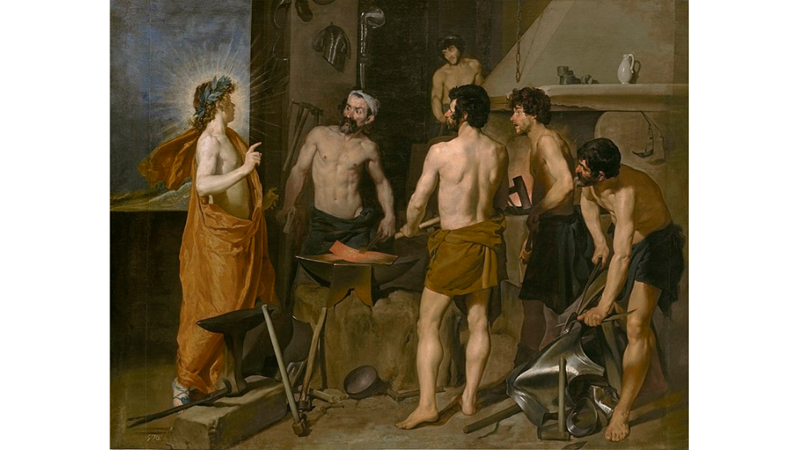Diego Velazquez tarafından 1630 yılında yapılan tablo, La Fragua de Vulcano (“Apollo in the Forge of Vulcan”) adındadır.
Tabloda, başındaki defne tacından tanıdığımız kehanetlerin tanrısı Apollo, demirci Tanrı Hephaistos’a kötü bir haber vermeye gelmiştir. Getirdiği haber karısı Aphrodite’in onu savaş tanrısı Ares (Mars) ile aldattığıdır.
Ares, savaşçı bir toplum olan Romalılar tarafından çok sevilse de Yunanlılar tarafından pek sevilmezdi. Yine de Yunanlıların aşk ve güzellik tanrıçası Aphrodite’le birlikte olmayı başarır. Aphrodite ve Ares’in yasak aşkından üç çocukları olur: Korku, Dehşet ve Uyum.
Velazquez’in tablosu antik çağların mitolojik dönemlerine ait bir hikayeyi anlatsa da oldukça ihtişamdan uzak resmedilmiştir. Apollo’nun kıyafetlerini saymazsak, sıradan bir demirci dükkanı havası yaratılmıştır. Resimde Apollo’nun saçtığı ışık ve Hephaisos’un yüzündeki şaşkınlık dikkat çekmektedir.
Eser, Madrid del Prado Müzesi’nde sergilenmektedir.
The painting, made by Diego Velazquez in 1630, is called La Fragua de Vulcano (“Apollo in the Forge of Vulcan”).
In the painting, Apollo, the god of prophecies, which we know from the laurel crown on his head, came to give bad news to the blacksmith God Hephaestus. The news he brought is that his wife, Aphrodite, cheated on him with the god of war Ares (Mars).
Although Ares was loved by the Romans, who were a warrior society, he was disliked by the Greeks. He still manages to be with Aphrodite, the Greek goddess of love and beauty. Aphrodite and Ares have three children from their forbidden love: Fear, Terror and Harmony.
Although Velazquez's painting tells a story from the mythological periods of ancient times, it is depicted far from magnificence. If we do not count Apollo's clothes, the atmosphere of an ordinary blacksmith shop has been created. The light emanating from Apollo and the surprise on the face of Hephaisos draw attention in the painting.
The work is on display at the Madrid del Prado Museum.


 Nielawore
Nielawore









Yorum yazmak için lütfen giriş yapınız